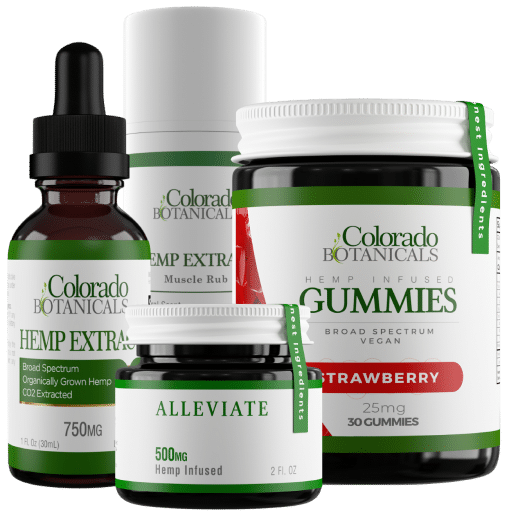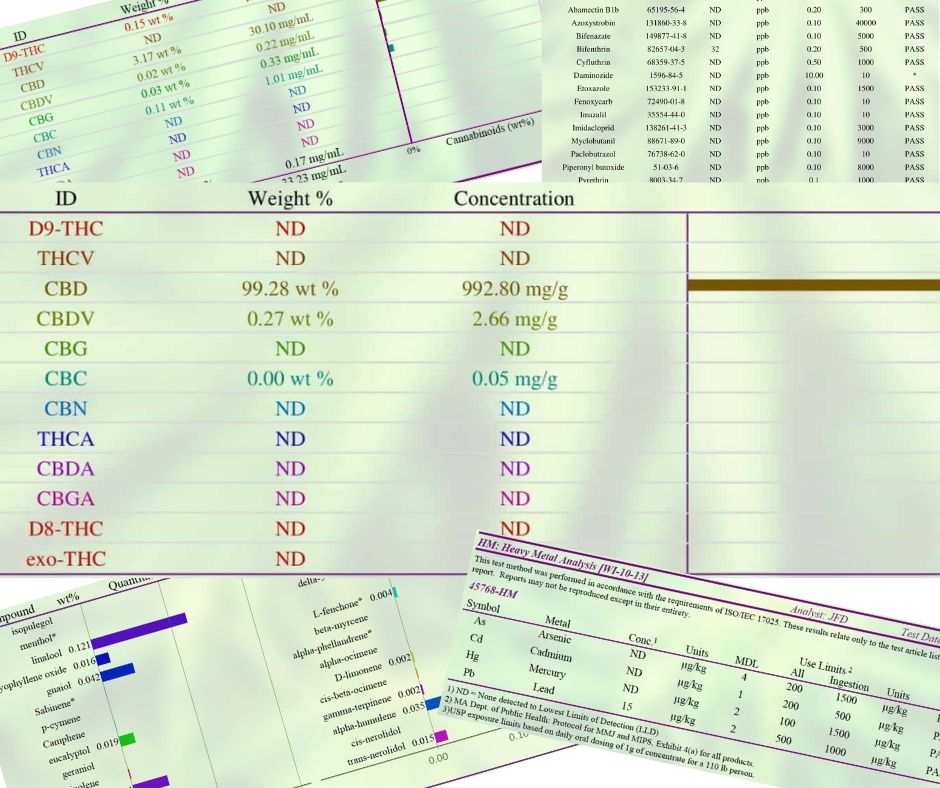
You’re searching for the best CBD product out there and you’ve learned about lab reports but you don’t understand what this stuff really says. For some, it may even seem like they’re trying to read a foreign language but it doesn’t need to be. This guide will break down how to read third-party lab reports of CBD products better than any other guide out there.
What is a Third-Party Lab Report or Certificate of Analysis (COA)?
A third-party lab report, also known as Certificate of Analysis (COA), is a report that is conducted by a licensed testing lab in the state and:
- provides unbiased tests results for transparency
- is completely unrelated to the company that it’s testing for
CBD and cannabis have grown into a large market to consumers all across the world, which leads to the concern of transparency & safety.
Why are lab reports on CBD products important?
Extracting CBD is a complex process and quality can vary significantly from company to company. The purification process can alter the end extract drastically depending on: the soil the hemp was grown on, the flower and leaves used from the hemp plants, and the extraction method.
Third-party lab reports are important because it shows full transparency of what the extract contains from the cannabinoid profile, heavy metals, E. Coli & Salmonella, and more. This assures consumers that the product they are purchasing is as advertised and safe to consume.

How to know a lab report is legitimate & authentic?
- Calling the lab that the product was tested by and provide them a “Certificate ID” that is shown on the Certificate of Analysis, which they can use to verify if the lab report is authentic.
- “In-House Test” should not be written anywhere on the report. Third-party lab reports usually have special markings on it, which does not allow others to duplicate.
What does “third-party lab tested” mean?
Seeing third-party lab tested on the packaging or a company’s website means that their products are tested by labs that are not affiliated to them, hence the term “third-party”. Just because a company mentions that it doesn’t mean you shouldn’t look for the lab reports to analyze before purchasing because any product can be just tested.
The whole purpose of getting products tested by third-party labs is to show the consistency that the product contains the actual advertised information and, most of all, for transparency. Since growing hemp and extracting CBD is a complex process, it’s crucial to make sure that the product a customer is purchasing is safe for them to ingest.
What is a Cannabinoid Profile Analysis?
This Cannabinoid profile of the lab report shows what cannabinoids and how much of those cannabinoids were found. The main cannabinoids which labs test for other than CBD or THC is THCV, CBG, CBC, CBN, THCA, CBDA, & CBGA.
More on THCA, CBDA, & CBGA is coming in another blog post so subscribe and don’t miss a post.
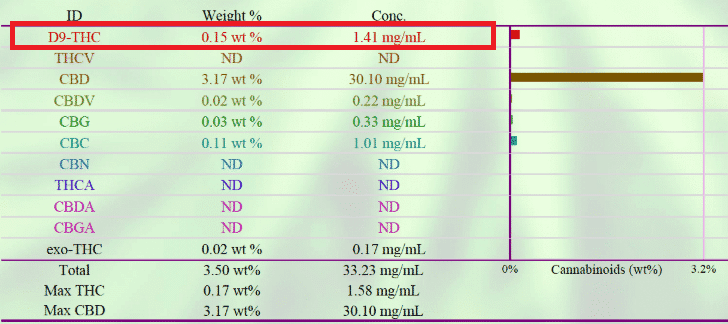
A Full Spectrum Extract product will show a lab report like this which contains THC, but less than the legal limit of 0.3%.
A Broad-Spectrum Extract product will show a lab report like this and as you can see it will contain Non-Detectable (ND) levels of THC.
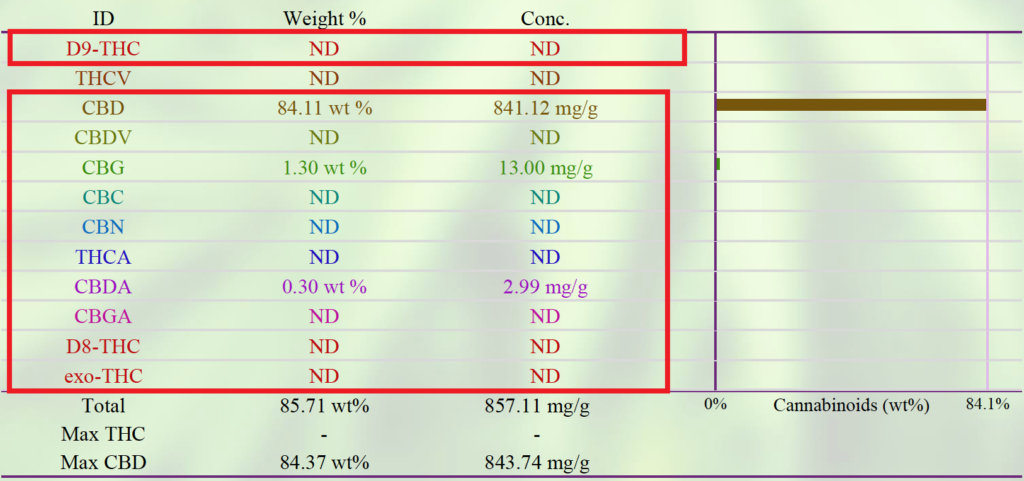
A Isolate lab report will look like this where the CBD purity is above 99%

ID: lists the cannabinoids that was tested for. These are also the major cannabinoids with the highest content found in cannabis and hemp; hence, the reason they are always focused on.
Weight%: Lists the percentage of cannabinoid that are in the extracted oil. When the raw oil is tested it will never be 99% pure of cannabinoids because the rest of the oil are full of lipids and fatty acids. Isolates will be more than 99%, but we advise not using isolate products as they are not as effective and without other cannabinoids, terpenes, and fatty oils it will not pass through your body as effectively. Studies have shown that cannabinoids are more effective when terpenes and flavonoids are intact.
Conc.: is the exact concentration that is in the total oil or product.
ND: Stands for Non-Detectable
When testing a tincture or edible, it should show the exact or close to amount CBD content as advertised because if it’s a 25mg CBD gummy then it should show ~25mg of CBD.
For example this is a 30mL 1,500mg CBD tincture, it contains 50.20mg per serving (50.20mg*30mL=1,506mg of CBD per 30mL).
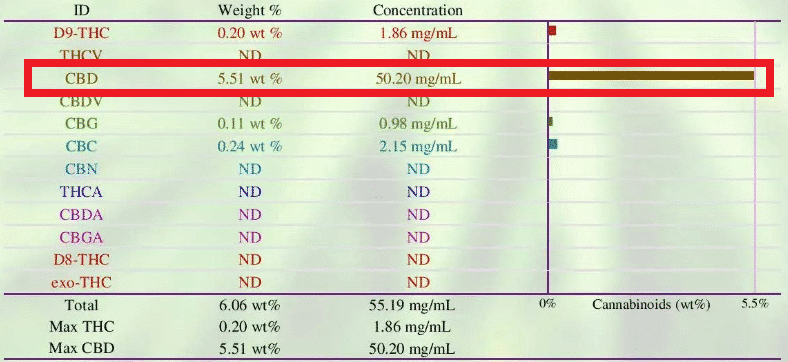
If it’s a tincture then they are testing for the amount of CBD per serving. So our 300mg will show 10mg of CBD, 750mg will show 25mg, and 1,500mg will show 50mg. At Colorado Botanicals we always add a little more to make sure we’re never below the dose that is advertised.
What is a Terpene Profile Analysis?
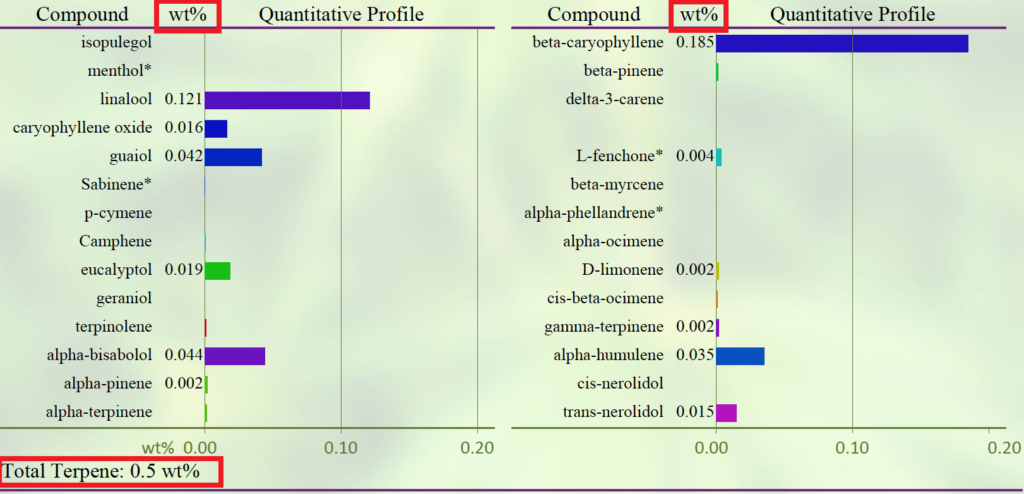
Terpenes are the naturally occurring compounds whose main purpose is to repel predators and lure pollinators. However, they also have an unusual unique property. Recent scientific research has shown that they can cause relaxation to pain-relieving features. More research is being conducted, but it’s no surprise that to extract CBD without this magnificent feature is to leave out a powerful component.
How to read a terpene profile lab test?
It’s simple. No matter what lab tests the product, the terpene is shown on the left side and on the right it will show the exact amount that was found in the product or extract that was tested.
In this case it shows weight percent (weight%), but it can also show PPM or ND.
PPM: Stands for Parts Per Million and describes the concentration of something. When the particle size is really small they use PPM to show the value.
1 PPM= 0.0001weight%
50PPM= .005 weight%
100 PPM= 0.1weight%
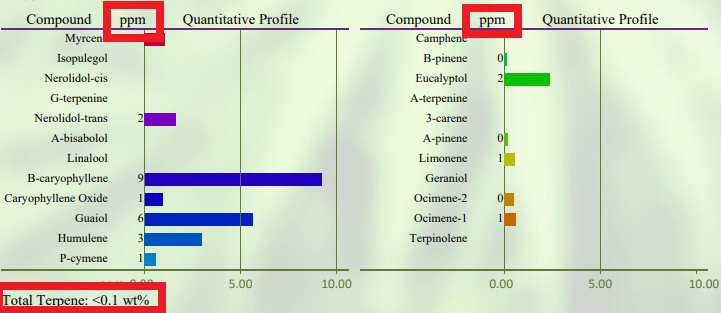
If you came across as lab report that shows PPM you can do a quick calculation using this converter: https://www.rapidtables.com/convert/number/PPM_to_Percent.html
ND: Stands for Non-Detectable which means no concentration of that terpene was detected. This goes for cannabinoids as well which we talked about in the cannabinoid profile section. Check below to see examples of PPM & ND outcomes that we found on the internet.
Why Third-Party Lab Testing is Essential
Since hemp is a natural Phytoremedition plant, it can easily absorb toxic residue from both the soil and air in the surrounding area. Phytoremediation is another very unique trait of hemp as this can be an excelling thing but also can be terrible.
The good:
For example, after the Nuclear Disaster of Chernobyl in 1986, hemp was used to clean the soil around the site. This was possible due to the process of phytoremediation, the “direct use of living green plants for in situ, or in place, removal, degradation, or containment of contaminants in soils, sludges, sediments, surface water, and groundwater.” Hemp is fast-growing, has deep roots, and is unaffected by the toxins that absorb through the soil, which makes this process possible.
The bad:
If the hemp is used for extracting cannabinoids–such as CBD, CBG, CBN, etc.–then it is crucial that the soil being used is clean of any toxic contaminants and continuously monitored throughout the season. Different sections of the farm must be consistently checked to make sure that no heavy metals, pesticides, and pollutants are found. If the soil is poor quality and low standard, then the consumer would be consuming a product that is not safe or clean.
Read more about this by clicking on this text. Now that you understand this concept, you should have a great understanding of why it’s essential to make sure the products you are buying don’t contain any harmful or toxic residue. That’s why companies should test for Heavy Metals, Pesticides, E. Coli, etc.
Heavy Metals Lab Test Analysis
A heavy metal test is a test that reveals the levels of toxic metals found in the product or extract. The most combination tests are for:
- Lead
- Mercury
- Arsenic
- Cadmium
People must be attentive to heavy metal levels because they are used for “industrial applications such as in the manufacture of pesticides, batteries, alloys, electroplated metal parts, textile dyes, steel, and so forth.” Due to the risk of that, toxicity can result from sudden, severe exposure, or from chronic exposure over time.”

Metal: Lists the heavy metals the test was tested for. These are the most common found and are what ProVerde Labs tests for.
Conc.: This shows the concentration or potency of the heavy metal that was tested. Although you may see very small traces of these heavy metals, it is nowhere near the amount that can cause any kind of harm.
Status: This is the most important, as it shows if the amount of the concentration that was found is safe to be ingested or not. A Pass means that you’re safe to consume the product, but if you see a Fail then you should stay away.
Pesticide Lab Test Analysis
Our last segment, the pesticide test, is important because hemp or cannabis may contain small amounts of pesticides and at certain levels can be toxic.
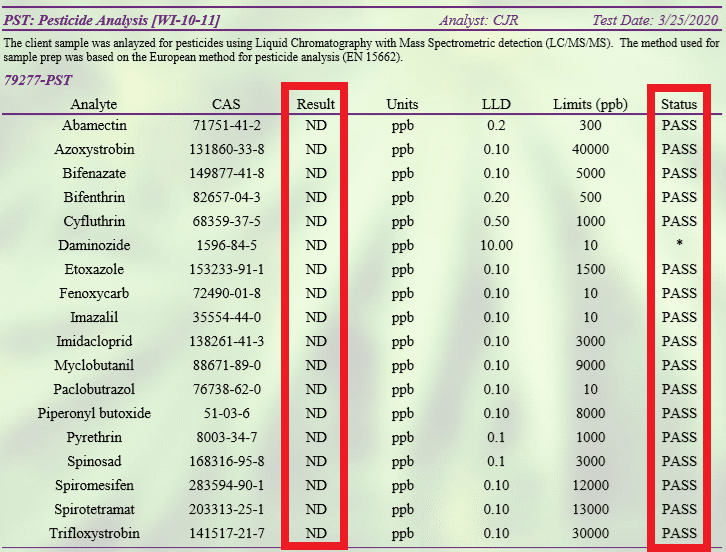
As usual on the left side, you will see the pesticides that have been tested and under Result, you will see how much was detected. From reading earlier you should know by now that ND means non-detectable, therefore in this lab report, no pesticides were found.
Units: This shows the unit value it was tested for and this case it was ppb which stands for “Parts Per Billion”.
Limits: this is the maximum value that can be found in the lab test for it to be passing. If it is above that value then the test will show “No Pass” since it has surpassed the regulations that were established in the State of California (these values can change depending on the state but in general the values are in this range)
Status: this column shows a “Pass” or “No Pass” if the levels are below or above the limit.
What to Remember from Third-Party Lab Reports on CBD Products
When purchasing CBD hemp oil you want to make sure you’re purchasing from a reputable company. Things have gotten much better in these past few months but before the market was filled with tons of unsafe and questionable products.
Summary of Third-Party Lab Reports
A cannabis or CBD third-party lab:
- provides unbiased tests results for transparency
- is completely unrelated to the company that it’s testing for
How to know a lab report is authentic?
- You may call the lab that the product was tested by and provide them a “Certificate ID” that is shown on the Certificate of Analysis, which they can use to verify if the lab report is authentic.
- “In-House Test” should not be written anywhere on the report. Third-party lab reports usually have special markings on it, which does not allow others to duplicate.
Lab Report Terms to remember:
Conc.: is the exact concentration that is in the total oil or product.
ND: Stands for Non-Detectable
PPM: Stands for Parts Per Million and describes the concentration of something. When the particle size is really small they use PPM to show the value.
Certificate ID: A number or phrase that is used to distinguish the lab report and can be given to the lab to authenticate the lab report.
Full Spectrum: A extract containing THC up to the legal limit of 0.3% Tetrahydrocannabinol (THC)
Broad Spectrum: An extract that is THC Free or contains Non-Detectable levels of THC
Isolate: A synthetic powder that is cut down to be 99%+ purity
Keywords: how to read third party lab reports certificate of analysis coa lab tests cannabis testing hemp testing cannabioid lab test terpene profile non detectable heavy metals pesticide understanding lab reports parts per million ppm



